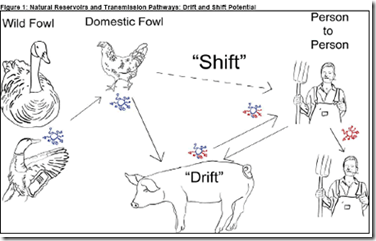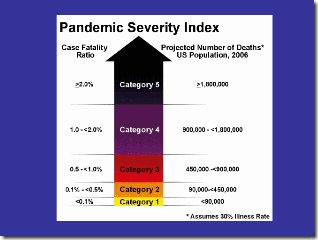# 3042
Pandemics are rated like Hurricanes. Category 1-5
The 1918 Spanish Flu was a CAT 5 Pandemic.
If my site meter is any indication, a great many people who don’t normally read flu blogs are hitting this, and other flu sites today.
Understandable, given the news of the past 48 hours.
While my regular readers are familiar with the basics of pandemics, it is probably a good time to review.
Don’t worry, I’ll be gentle.
First, you need to know that scientists have been expecting another pandemic to come around for years.
Influenza viruses, you see, are notorious for being unstable.
They mutate constantly, which is why we need a new flu shot every year. The changes from year to year are often minor, but even a tiny antigenic shift or drift in the virus can render your last flu shot useless.
Every once in awhile, we see a major change in an influenza virus. It can jump species to humans (as we believed happened in 1918), or it can acquire genetic material (reassortment) from another flu virus and create a new hybrid.

Fig. Birds, humans, and Pigs are all susceptible to Influenza
In either event, you can end up with a new (novel) virus to which humans have little or no immunity.
If the virus is also easily transmissible, and it produces illness in humans, you have the ingredients for a pandemic.
Roughly every 30 to 40 years for at least the past 3 centuries the world has seen an influenza pandemic. Sometimes these pandemics are mild or moderate, but on rare occasions they can be horrific.
The last true pandemic was in 1968, and the culprit was the Hong Kong Flu.
As pandemics go, it was pretty mild. It probably only killed a million people or so.
Before that, you only had to go back 11 years, to 1957 and the Asian Flu. A more lethal pandemic than 1968, the Asian Flu killed perhaps 4 million people.
The Granddaddy of flu pandemics occurred in 1918, and that was the Spanish flu. Somewhere between 50 and 75 million people are estimated to have died over an 18 month period.
We’ve also had `close calls’, such as the Swine Flu Scare of 1976, the Liverpool Flu of 1951, and the pseudo-pandemic of 1947.
In 1977, the H1N1 virus returned after an absence of 20 years, possibly due to an accidental release from a laboratory in the former Soviet Union.
It is also likely that we’ve been close to a pandemic other times, and simply were oblivious to the fact.
For the past 10 years we’ve been watching the H5N1 `Bird Flu Virus’ as it has moved out of Central China, to the Middle East, Indonesia, and parts of Europe.
The H5N1 virus has `pandemic potential’, but luckily hasn’t acquired the ability to spread from person to person easily.
The WHO (World Health Organization) has had the world on pandemic alert level 3 since 2005. The emergence of this new Swine Flu virus may force a move to Level 4 in the coming days.
We’ve also been watching other influenza viruses, like the H7s and H9s. All of these viruses are still out there, and are still potential problems, regardless of what happens with this `swine flu’.
While birds are the natural host for influenza viruses (in effect, all flu’s are `bird flu’) the virus can affect other animals as well, including humans, dogs, horses, ferrets, and pigs.
Pigs are particularly worrisome since they can contract both human, and avian (bird) flu strains. They can even conceivably be infected by more than one strain of flu at a time, and serve as a `mixing vessel’, turning out a new, hybrid flu.
What we seem to be seeing is a new hybrid of the H1N1 virus with a mixture of human, swine, and avian flu genes.
It may have been circulating, below our surveillance screen, for a while. But it is obviously spreading with some rapidity now.
In Mexico, authorities believe this new hybrid `swine’ flu has infected more than 1,000 people and killed 80 or more. The numbers coming in are murky, at best, and we really can’t draw any good conclusions based on what has been reported.
Where this flu goes from here is hard to know.
It could burn itself out. It could mutate into a milder flu, or lose its ability to transmit from human-to-human.
We’ve seen other pandemic scares, like SARS in 2003 and the Swine Flu of 1976, simply peter out.
Why?
Well, we really don’t know.
But this new Swine Flu virus could also continue to spread, and it might even pick up virulence. If that happens we are likely to see wide variances between regions as far as the level of illness or death it produces.
So, we watch.
And we wait for the science to bring us better answers than we have right now.
That may take days, or even weeks.
In the meantime, if you haven’t begun to prepare your business, and your family, to deal with a pandemic. Now is the time to do so.
My sidebar has a wealth of resources, but here are a few links to get you started.
It Is Not To Late To Begin To Prepare
Dr. Grattan Woodson's Home Treatment of Influenza




